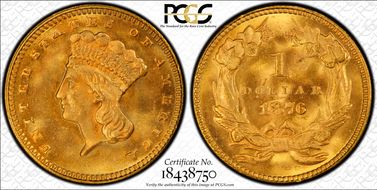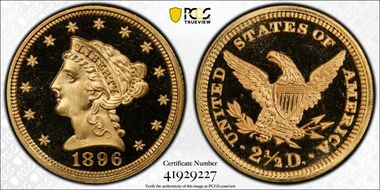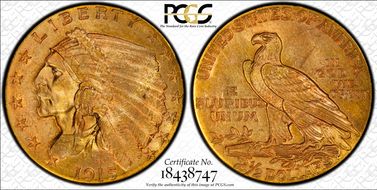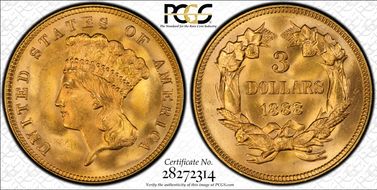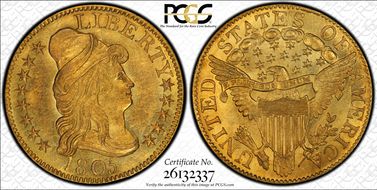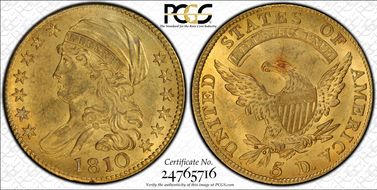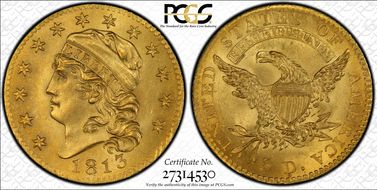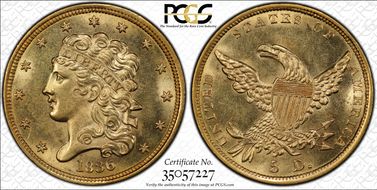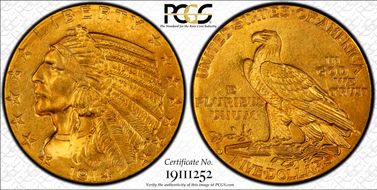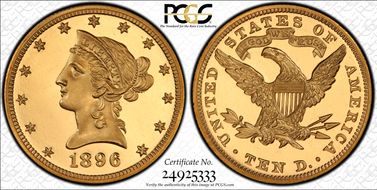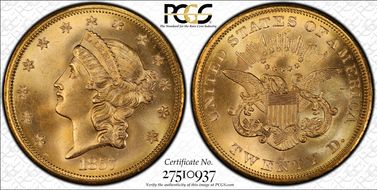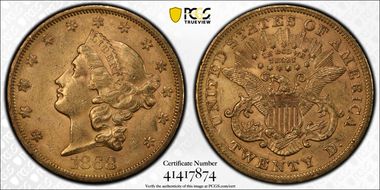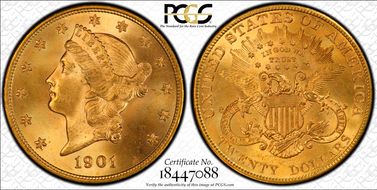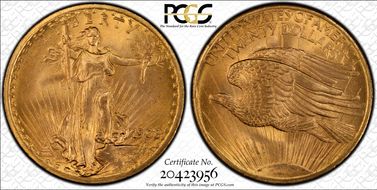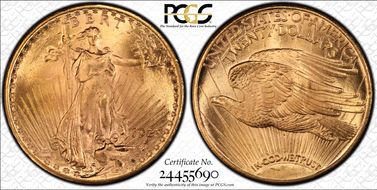The Gypsy Collection by Jesh 的钱币相册
CAC. Orange-red and olive-green toning is beautiful, and the obverse appears immaculate.
CAC. Orange-red and olive-green toning is beautiful, and the obverse appears immaculate.
CAC. Breen-6444, BD-3, High R.5. A moderate mintage of 33,183 Capped Bust Right half eagles was achieved in 1805, with five different die marriages known to collectors today. The coin offered here is an example of the rare BD-3 variety, characterized by the imperfect 1 in the date, star 1 distant from the bust, and star 9 close to Y in LIBERTY. John Dannreuther estimates an initial mintage of 2,000-3,000 pieces for BD-3, with a surviving population of 35-45 examples. The present coin is an attractive example, with noticeably prooflike fields. Heavy clash marks can be seen in the right reverse field, with some adjustment marks in the center obverse. Sharply struck, with exquisite detail on the central devices, and only slight weakness on the peripheral stars. A few scattered field marks prevent an even higher grade. Population (all varieties): 44 in 62, 58 finer (11/11).
CAC. Breen-6444, BD-3, High R.5. A moderate mintage of 33,183 Capped Bust Right half eagles was achieved in 1805, with five different die marriages known to collectors today. The coin offered here is an example of the rare BD-3 variety, characterized by the imperfect 1 in the date, star 1 distant from the bust, and star 9 close to Y in LIBERTY. John Dannreuther estimates an initial mintage of 2,000-3,000 pieces for BD-3, with a surviving population of 35-45 examples. The present coin is an attractive example, with noticeably prooflike fields. Heavy clash marks can be seen in the right reverse field, with some adjustment marks in the center obverse. Sharply struck, with exquisite detail on the central devices, and only slight weakness on the peripheral stars. A few scattered field marks prevent an even higher grade. Population (all varieties): 44 in 62, 58 finer (11/11).
CAC. Purchased as MS63/CAC. State c/b. Die clashing is seen most notably at the top of the obverse above the cap. This common early gold type coin has an estimated survival of 500 to 750 pieces, out of an a total of 75,000 to 90,000 originally minted. Of course, the vast majority of those produced were melted from the date of issue through 1834, at which time gold coins became worth less than their intrinsic value. This is a lovely orange-gold example whose color is only interrupted by a spot of copper (from improper mixture of the gold/copper alloy in that area) over the eagle's eye. The devices are sharply struck throughout, and there are no obvious or detracting abrasions. (Upgrade from MS63) EX: Oliver Collection PCGS 1/35 (05/15)
CAC. Purchased as MS63/CAC. State c/b. Die clashing is seen most notably at the top of the obverse above the cap. This common early gold type coin has an estimated survival of 500 to 750 pieces, out of an a total of 75,000 to 90,000 originally minted. Of course, the vast majority of those produced were melted from the date of issue through 1834, at which time gold coins became worth less than their intrinsic value. This is a lovely orange-gold example whose color is only interrupted by a spot of copper (from improper mixture of the gold/copper alloy in that area) over the eagle's eye. The devices are sharply struck throughout, and there are no obvious or detracting abrasions. (Upgrade from MS63) EX: Oliver Collection PCGS 1/35 (05/15)
CAC. BD-1, R.2. Bass-Dannreuther Die State b/b. The Capped Bust Left design was modified in 1813, with the bust and eagle restyled and the stars arranged in a continuous arc above the portrait, instead of the 7x6 arrangement of the previous design. A substantial mintage of 95,428 pieces was achieved, with only two die varieties known for the date. This coin represents the more available BD-1 variety, identified by the position of the first S in STATES over the right side of E in PLURIBUS. The BD-1 is the only readily available date and variety of this design type, making it a favorite choice of type collectors. The BD-1 probably accounted for 60,000-75,000 pieces of the reported mintage, with a surviving population of 450-650 examples in all grades. John Reich's secret signature star punch, with the notched outside point, was used on star 13. The obverse die was also used to strike the BD-2 variety of this date, but the BD-1 is the only use of the reverse die. As a date, 1813 half eagles have been avidly collected since the 1850s, with an example appearing in lot 187 of the A.C. Kline Sale (Moses Thomas & Sons, 6/1855). More recent sales include the appearance of the present coin in lot 5093 of the FUN Signature (Heritage, 1/2011), which realized $48,875. The coin offered here is a spectacular near-Gem example, with pleasing yellow-gold surfaces and strong rose highlights at the peripheries. The design elements are sharply detailed, and vibrant mint luster beams on both sides. A few light adjustment marks appear on Liberty's cheek on close inspection, but they have little impact on the coin's extraordinary visual appeal. Population: 48 in 64, 3 finer (6/12). 48/4 (1/14)
CAC. PCGS Secure. The 1914-D half eagle, with a mintage of 247,000 coins, is a rare issue in higher grades, as the population data reveals. This highly lustrous and frosty example has brilliant honey-gold luster with pristine surfaces. Only two 1914s of any grade have received a Plus designation. Population: 2 in 64+, 14 finer (7/10).
CAC. PCGS Secure. The 1914-D half eagle, with a mintage of 247,000 coins, is a rare issue in higher grades, as the population data reveals. This highly lustrous and frosty example has brilliant honey-gold luster with pristine surfaces. Only two 1914s of any grade have received a Plus designation. Population: 2 in 64+, 14 finer (7/10).
CAC. While the official mintage of 78 proof 1896 ten dollar coins might suggest that the date is relatively available, circumstantial evidence suggests that that output was an overreach. Not only were mintages of proof eagles lower in the next two years (69 and 67 pieces, respectively), but the estimated survival of the 1896 ten dollar proofs is close to that of the 1897, with the 1898 pieces seeing a spike in the survival rate despite a slipping mintage. PCGS suggests that 35 to 45 specimens survive for the 1896 and 1897 dates, compared to "40 to 50 known" for the 1898 issue. The PCGS Population Report lists 25 certification events for the 1896 ten dollar proof, 16 with Cameo contrast and nine labeled Deep Cameo. (It should be remembered that the period from 1896 to 1898 was a high-water mark for the cameo effect in U.S. silver and gold proof coinage.) A majority of the coins are in the PR64 range; among Deep Cameo pieces, this is one of just two certified by PCGS with three numerically finer as Deep Cameo, all graded PR66 (2/12). Effectively black-and-gold contrast is on display with this Deep Cameo Gem, thanks to sharply struck, thickly frosted devices paired with fields that combine so-called "orange-peel" texture with a great overall mirror finish. A thin, curving blemish just off the bridge of Liberty's nose and a depression to the left of star 9 are the most reliable pedigree markers. (Upgrade from 65). PCGS 65DCAM 2/3 (02/12) PCGS 65+DCAM 1/15 (05/15)
CAC. While the official mintage of 78 proof 1896 ten dollar coins might suggest that the date is relatively available, circumstantial evidence suggests that that output was an overreach. Not only were mintages of proof eagles lower in the next two years (69 and 67 pieces, respectively), but the estimated survival of the 1896 ten dollar proofs is close to that of the 1897, with the 1898 pieces seeing a spike in the survival rate despite a slipping mintage. PCGS suggests that 35 to 45 specimens survive for the 1896 and 1897 dates, compared to "40 to 50 known" for the 1898 issue. The PCGS Population Report lists 25 certification events for the 1896 ten dollar proof, 16 with Cameo contrast and nine labeled Deep Cameo. (It should be remembered that the period from 1896 to 1898 was a high-water mark for the cameo effect in U.S. silver and gold proof coinage.) A majority of the coins are in the PR64 range; among Deep Cameo pieces, this is one of just two certified by PCGS with three numerically finer as Deep Cameo, all graded PR66 (2/12). Effectively black-and-gold contrast is on display with this Deep Cameo Gem, thanks to sharply struck, thickly frosted devices paired with fields that combine so-called "orange-peel" texture with a great overall mirror finish. A thin, curving blemish just off the bridge of Liberty's nose and a depression to the left of star 9 are the most reliable pedigree markers. (Upgrade from 65). PCGS 65DCAM 2/3 (02/12) PCGS 65+DCAM 1/15 (05/15)
CAC. Spiked Shield, Variety 20A. Ex: S.S. Central America. SSCA 2796. The Central America went from being an almost-forgotten maritime disaster to an oft-told treasure tale after the discovery of the wreck -- and the golden cargo within. This Premium Gem 1857-S double eagle was one of thousands packed tightly together on the ship and bound for New York with who-knows-what eventual fate when a hurricane sank the Central America. After more than a century and a quarter, this coin and its fellows changed collector understanding of the 1857-S double eagle forever. Despite being packed for shipping, riding through two rough oceans, sinking in a hurricane, and being raised from the ocean floor, this Premium Gem has come through hardly the worse for events (and obviously with no wear). Canary-gold luster, bright and pale, deepens slightly toward the rims. A tiny mark along Liberty's chin is well within the bounds of the grade. Offered alone (no box or paperwork), but this coin and its gold-insert holder carry their own credentials. From The Richard P. Ariagno, M.D. Collection
CAC. Purchased as MS65/CAC, upgraded to MS66/CAC, this elegant Gem survivor from this turn-of-the-century issue is sharply struck with vibrantly lustrous wheat-gold and mint-green surfaces and marvelous visual appeal. The portrait is especially clean, with only a handful of minuscule luster grazes away from the focal points. PCGS 4/0 (5/15)
CAC. Purchased as MS65/CAC, upgraded to MS66/CAC, this elegant Gem survivor from this turn-of-the-century issue is sharply struck with vibrantly lustrous wheat-gold and mint-green surfaces and marvelous visual appeal. The portrait is especially clean, with only a handful of minuscule luster grazes away from the focal points. PCGS 4/0 (5/15)
CAC. Short Rays obverse. Part of a remarkable hoard of No Motto 1908 double eagles that was set aside until late 1999, when the coins were certified by PCGS and successfully marketed. This butter-gold Premium Gem is splendidly preserved and has pleasing eye appeal, as usual for the Wells Fargo pedigree.
CAC. Short Rays obverse. Part of a remarkable hoard of No Motto 1908 double eagles that was set aside until late 1999, when the coins were certified by PCGS and successfully marketed. This butter-gold Premium Gem is splendidly preserved and has pleasing eye appeal, as usual for the Wells Fargo pedigree.
CAC. The surfaces of this high-end Premium Gem are virtually pristine with no distractions visible to the naked eye. The design elements are sharply detailed in most areas, though a little softness is evident on the Capitol and lower stars. The surfaces display vibrant mint luster with outstanding eye appeal. Population: 11 in 66+, 5 finer (5/11)
CAC. The surfaces of this high-end Premium Gem are virtually pristine with no distractions visible to the naked eye. The design elements are sharply detailed in most areas, though a little softness is evident on the Capitol and lower stars. The surfaces display vibrant mint luster with outstanding eye appeal. Population: 11 in 66+, 5 finer (5/11)





















